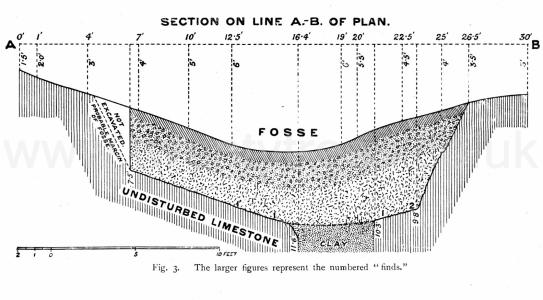Biography of Reverend William Greenwell 1820-1918
Reverend William Greenwell 1820-1918 is in Archaeologists.
Before 23 Mar 1820 [his father] William Thomas Greenwell (age 43) and [his mother] Dorothy Smales were married.
On 23 Mar 1820 Reverend William Greenwell was born to William Thomas Greenwell (age 43) and Dorothy Smales at Greenwell Ford, Lanchester.
Durham University Journal 1918 February Volume 21 Number 20. In 1856 Mr Greenwell (age 35) returned to Durham and was made a Minor Canon of Durham Cathedral [Map], which office he retained till 1909. At the same time he became Chaplain and Censor of Cosin's Hall. In 1864 this Hall was closed and next year he was appointed to the living of St Mary the Less. in the South Bailey, Durham. and continued Rector of this little parish till he died.
In 1856 [his father] William Thomas Greenwell (age 79) died.
Proceedings of the Cotteswold Naturalists' Field Club Volume 5 Page 277. In addition to the works already mentioned as existing on Minchinhampton Common there remain to be described numerous low mounds, to which the attention of the Club was especially directed on the occasion of its visit there in ay, 1869. The following is a brief summary of 40 of these mounds:
Five are circular, from 20 to 40 feet in diameter, and about 18 inches high; thirty-five are oblong, from 30 to 180 feet in length, about 24 feet in breadth, and 24 inches in height. In the construction of these oblong mounds great uniformity has been observed in their width and height. Their directions are very various— sixteen are nearly N. and S., and ten nearly E. and W. The object for which these mounds were made is as yet an unsolved enigma. The examinations made by the Club in 1869 under the valued superintendence of Mr. Cunniugton, and the many previous and subsequent openings made, have failed to bring to light any evidence that they are places of interment. The original surfaces of the soil beneath them are not found to present any sign that cremation has there taken place, and no human remains burned or unburned have as yet been detected in the mounds. In some instances they have been formed by first placing the mould in the centre, and then heaping over it rubble ; in other cases the lines of the original ttirf and mould remain in situ, covered directly with rubbly soil. Scattered sparingly in the mounds are found pottery, charcoal, iron slag, pebbles, and a few flint chips. In one small circular mound near Amberley, numerotis small pieces of pottery were observed to He on what had been the surface of the mound before the formation of the present tui-f, whilst none were found in the body of the mound. Having sent a description of these earthworks to the Rev. Canon Greenwell (age 48), of Durham, he very kindly replied — "I have observed a large number of circular mounds, evidently artificial, and which in many cases were close to larger mounds, in which burials have been found. These smaller mounds occur in groups of sometimes fifty or sixty. I never found the least trace of any burial in them, or the slightest fragment of pottery or chipping of flint. My explanation is that they covered unburnt bodies, interred without vase or implement, and that from the slight covering over them, so allowing the air free admission, all trace of the body has disappeared. This explanation is, I confess, not satisfactory to my own mind, but I cannot suggest any other which appears to be more reasonable. I have also opened several oblong mounds in Yorkshire and Westmoreland with the like results. In Westmoreland they are called ' giants' graves/ and are very numerous ; the size is, however, very much less than those you refer to in your locality, being not more than from 20 to 30 feet long, and from 6 to 8 wide, and about 1^ to 3 feet high. All those I opened had never suffered from the action of the plough or from any other disturbance."
In 1898 Reverend William Greenwell (age 77) was awarded the Medal of the Royal Numismatic Society.
Wiltshire Archaeological Magazine 1907 V35 Pages 1-20. No. 17. Nine feet almost due south of the skeleton and 1ft. 2in. below the present surface, a vessel of the cinerary urn type was disclosed. It had been crushed into several pieces by the weight of the earth above, and was also slightly damaged by the workman's pick; it has, however, been repaired and is now complete. It stood in an upright position, but with no signs of ashes or of burnt material of any sort inside it, nor was there any sign of an interment, burnt or unburnt, near it1. Immediately beneath it the earth was a little reddened and discoloured as if by fire, and there were a few specks of charcoal; but the traces of fire were slight, and quite local. The vessel might be chosen as typical of a cinerary urn from its general shape and heavy overhanging rim, which latter feature Canon Greenwell (age 86) says may be regarded as the principal characteristic of this class of urn2. But in spite of its form, as it contained no bones or ashes, one is forced to the conclusion that it may have served the purpose of a food vessel, and that it had probably contained some form of food offering made to the dead at some time subsequent to the burial, and during or after the piling up of the barrow.
Note 1. Canon Greenwell (age 86) says: "In a few instances a sepulchral vase has occurred in a barrow not in close proximity with any interment," British Barrows, p. 61.
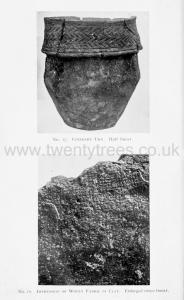
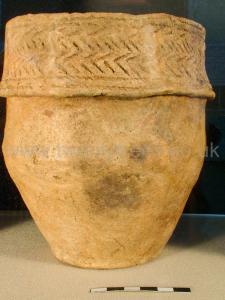 Collared urn decorated with vertical lines around rim and 2 rows of cord impressed chevrons around collar bordered by two cord impressed lines at top and bottom, found upright in cist with no cremated remains. Collection of [Map].
Collared urn decorated with vertical lines around rim and 2 rows of cord impressed chevrons around collar bordered by two cord impressed lines at top and bottom, found upright in cist with no cremated remains. Collection of [Map].
Wiltshire Archaeological Magazine 1907 V35 Pages 1-20. No. 15. This small rude cup-like vase should perhaps be classed as belonging to the type known as "incense cups". It is decorated with a series of small oblong punctures in would-be vertical rows, the rows are fairly straight at first, but the artist seems soon to have got into difficulties, and the lines become increasingly slanting until they are at such an angle that they never reach the bottom at all, and are allowed half-way down the side to merge into the other lines. The more perfect portion of the rim is J of an inch in width, and has been decorated with a chevron pattern of lines drawn from edge to edge; the triangular spaces between the lines have punctured dots in them, and these dots and lines appear to have been filled in with some white stuff as if for the purpose of making the pattern stand out more clearly. Canon Greenwell (age 86) mentions a somewhat similar case, where a pattern seems to have been emphasised by means of a white substance filling in the lines on an incense cup from a barrow at Aldbourne, Wilts1. One half of the cup is much more crumbly and decayed than the other; from this part the white filling is absent and the edges are blackened as if it had been in a fire, and more affected by it on one side than the other. It would seem that the crudeness of the ornamentation could only have been the result of sheer carelessness, or of an intelligence and skill equal to that of a child.
Archæogia, LII., p. 53. The same peculiarity may be seen on a drinking cup from Roundway Down, in the Museum at Devizes.
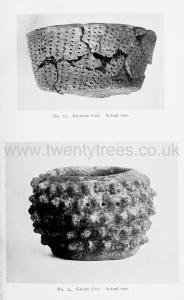
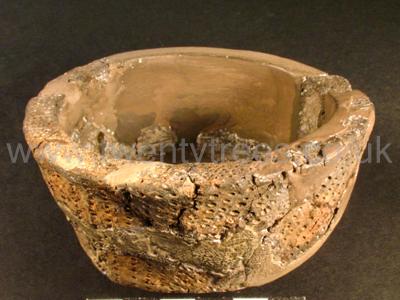 Miniature (incense) cup with vertical and diagonal lines of impressed dots around body, and forming zig-zags around rim. Collection of [Map].
Miniature (incense) cup with vertical and diagonal lines of impressed dots around body, and forming zig-zags around rim. Collection of [Map].
Wiltshire Archaeological Magazine 1907 V35 Pages 1-20. No. 7. One hundred and fifty small fiat circular beads of jet or shale (only one hundred and forty-four are represented here, as six are preserved in a piece of clay, as found1.
No. 7a. Largest bead.
No. 7b. Smallest bead.
No. 7c. Fossil encrinite used as a bead.
Note 1. Beads apparently identical with these have been found, by Canon Greenwell (age 86), British Barrows, p. 419, fig. 159; by J. K. Mortimer, "Burials Mounds of East Yorkshire," p. 138, Pl. XLIV.; ibid, p. 223, Pl. LXXVII.; and at Lake, Ancient Wilts, p. 210, Stourhead Cat., No. 172b.
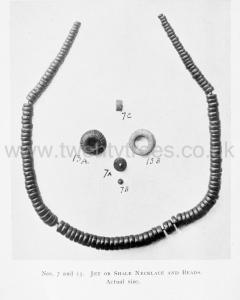
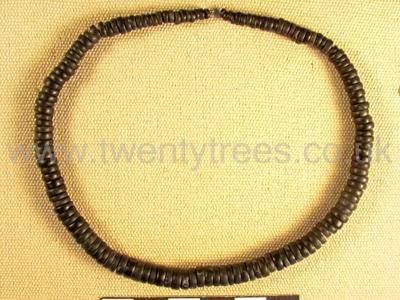 150 shale beads from a shale bead necklace. Collection of [Map].
150 shale beads from a shale bead necklace. Collection of [Map].
Durham University Journal 1918 February Volume 21 Number 20. 1913. The Durham University Journal. In Memoriam.
In the death of Dr Greenwell (age 92) Durhalll University has lost its oldest and most distinquished graduate and one whose recollections went back almost to the foundation of the University itself. The name of one of his contemporaries, Charles Richard Robinson. M.A., Univ. 1839, still remains in the Calendar. but we have no information as to whether he is still living. As he took L. Th.. apparently with the purpose of entering Holy Orders, and his name is not in Crockford, he probably is not. William Greenwell was the son of William Thomas Greenwell. J.P., D.L., and was born at Greenwell Ford, near Lanchester, on March 23rd. 1820. His father was owner of Greenwell Ford. as his ancestors had been before him from the days of Henry VIIl. There were other children. One was the Rev. Alan Greenwell, who was Rector of Colborne, Lancashire, Chaplain of Durhanm Gaol, and then Vicar of Haydock, Lanes. Another was Dora Greenwell, the saintly poetess and essayist, who wrote "Carmina Crucis," and other works.
William first went to Witton-le-Wear Preparatory School, a famous Northern School in its time, though it no longer exists, and then to Durharn School where one of his contemporaries was Henry Baker Trisham, afterwards Canon of Durham. He matriculated at University College (then only tour years old) in 1836, and took his B.A. in 1839. He was intended for the Law and soon afterwards entered the M iddle Temple. For reasons of health, however, he had to leave London, so he returned to Durham, took the L. Th. in 1842, and the M.A. in 1843. In the following year he was ordained deacon by Bishop Maltby and in 1846 priest. As he appears to have had no cure of souls he was apparently ordained on the Pemberton Fellowship, which he Imeld from 1844-54. From 1844 to 1847 he was Bursar and Chaplain of University College. In the latter year he was appointed Vicar of land, and in 1852 he became Principal of Neville Hall.. This was a house which was opened at No. 1 Leazes Terrace, Newcastle, as a Hall of Residence for students of the College of Medicine, but not enough students came to it to make it a success and it only lasted a short time.
On 27 Jan 1918 Reverend William Greenwell (age 97) died unmarried at his home 27 South Bailey, Durham.
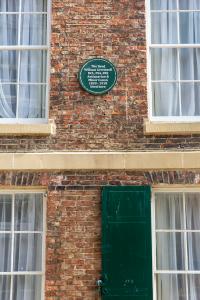
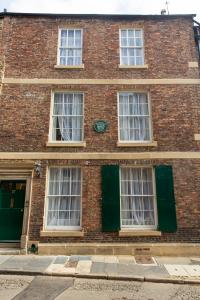
Long Barrows of the Cotswolds. (4) Cist, marked F on the plan. "In it were found the bones of but a single individual, a young person between the age of 12 and 16 ... and an urn1 of black, coarse ware of quite different character from the one already spoken of as found placed superficially to the second 'cist' [and which he calls a 'drinking-cup'] . This cist was about 4 feet square ; it was close upon the southern wall of the barrow, and about 85 feet from the re-entering angle of its eastern end." Lastly, outside the cists altogether "at about 17 or 18 feet westwards from the centre point of the eastward end were found some bones of a child with the milk dentition in place, about 2 feet or halfway down in the barrow. Parts also, of an ulna, of a tibia, of the phalanges and of both temporals of an adult, were found at about the same distance from the east end, and at a point a little south by west of the middle line."
Note 1. Canon Greenwell adds the following description (Brit. Bars., p. 520):- "In front of the knees was part of a vessel of pottery, including a considerable portion of the rim, which had not been less than 9 inches in diameter. It is dark coloured and quite plain, having some broken stone mixed with the clay ; the bottom has been rounded and the rim has a recurved lip. It differs entirely from the ordinary sepulchral ware of the round barrows, but corresponds with pottery I have found in the condition of pieces of broken vessels on several occasions in the barrows of the Yorkshire Wolds. It has been in general shape not unlike Fig. 91, though not so flat on the bottom and somewhat deeper." A drawing of the pot is given here. It is now in the British Museum, and I am indebted to Mr. E. Thurlow Leeds, for drawing my attention to it, and to Mr. Kendrick for having the drawing made.
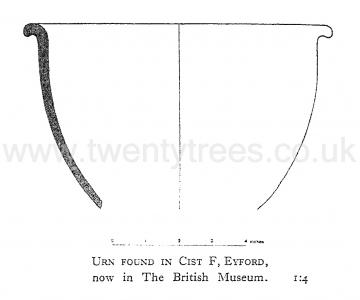
The Clay Floor. Purple clay resembling that of which the floor was made may still be found on the limestone.
The partial examination of the inner area by means of the various trenches suggested that the floor extended over the whole of the part lying to the west of a line drawn at right angles to the axis at the portal, with the possible exception of the immediate neighbourhood of the chamber itself. Eastwards of this line the evidence was not so clear, and any systematic exploration was impossible owing to the amount of material already heaped in position around and above the passage and chamber. The presence of clay floors, or "strata," in tumuli, has been noted in a few other cases, e.g. by Canon Greenwell, in the Ebberston long barrow in the North Riding of Yorkshire (British Barrows, pp. 485—6), and in a round barrow in the parish of Rudstone in the East Riding (p. 246). It is likely that it has escaped notice in other excavations.
By the time the floor had been discovered it was too late to ascertain its relation to any other uprights of the chamber and passage than No. 3, but the available evidence clearly suggests that the chamber was completed before the floor was laid down, and it is quite certain that it was laid down after both upright No. 3 of the chamber and the pattern stone were in position.
Nænia Cornubiæ by William Borlase Introductory Preface. To John Evans, Esq., F.R.S., to Sir Edward Smirke, and to the Society of Antiquaries, the author is indebted for permission to reproduce drawings from their works; while to the Rev. Canon Greenwell, of Durham, F.S.A., and to Albert Way, Esq., F.S.A., he must express his especial thanks for their goodness in replying to several troublesome Antiquarian queries.
Cumbria and Westmorland Antiquarian and Archaeological Society. 1st. Variety in the Interments. For instance an exploration of the circle No. 4. disclosed a deposit of burnt bones lying in the soil, accompanied by a food vessel; in cairn No. 5. the calcined bones and ashes had been held in a mortuary urn; whilst under the White Raise or No. 10. there was found inhumed in a stone coffin the whole skeleton in a doubled-up position.
The same story is told by Canon Greenwell and other barrow explorers, that burial by inhumation and by cremation was coeval, and was practised by the same people at the same period of time, and that the two modes of sepulture had been found existing in the vicinity of each other, or even under the same superincumbent barrow.
The recent discoveries in the neighbourhood of Penrith, in respect to the contents of prehistoric graves, indicate that in this part of the country at least, the usage of cremation and that of inhumation and cist burial were practised indiscriminately. Under the Redhill sculptured stone1, I found the cremated remains without an urn; at Moorhouses the calcined bones in an urn; within the Leacet circles2 as described by Mr. R. S. Ferguson, and Mr. Joseph Robinson, the interment had been by cremation, and there were found five cinerary urns, a food vessel, and an incense cup; whilst under the Clifton barrow we had two kist-vaens with unburnt skeletons in company with their food vessels.2 great 100 feet circle No. 13. or the 'Cockpit,' there is a higher development, which brings it into association with some of our most important megalithic monuments. Along and within the circumference of the big inclosure, there are four subordinate segmental sepulchral circles. So we find the great 100 feet Keswick circle, to contain in the same manner on its eastern side an accessory stone inclosure, and also the site of a circular barrow; the 100 feet circle at Eskdale Muir [Map] includes within its ring five circular tumuli; the 100 feet double circle at Gunner-keld [Map], has within its inner belt a segmental chamber; the same feature is presented by the analogous circle at Oddendale [Map] near Shap.
Note 1. Trans. Cumb. and West. Arche ol. Soc. vol. vi. p. no.
Note 2. Ditto. vol. v. p. 77.
Note 2. Ditto. vol. v. p. 90.
Nænia Cornubiæ by William Borlase Lanyon Cromlech. The different modes of disposing of the body, which meet the explorers of the early sarcophagi of Great Britain, are three in number. Interments have either been placed in the ground whole, or they have been reduced to ashes by (i) cremation. Those bodies which have been buried in their entirety are either (2) extended or (3) contracted. Leaving the subject of cremation for a future page, it may be remarked with reference to the practice of inhumation, that throughout the North of England it is by far the most common mode of burial; and that in England generally the contracted form of it has been found to have prevailed very largely over the extended. Thus the Rev. Canon Greenwell, in a letter dated the 12th of December, 1871, informs the author that "out of above 200 interments of what may be considered pre-Roman times," he has only found "a single instance where the body had been buried in an extended position." So much for the North.
Cumbria and Westmorland Antiquarian and Archaeological Society. It is a charming little prehistoric gem in the way of a sepulchral circle. These lichen-covered boulders, standing in their pristine entirety, set up in their annular line, projecting their bossy outlines above the reedy grasses and heather of this desolate moor, appeal to us as the silent sentinels of the burial fires of a bygone race. The stones may be said to be eleven in number, eight principal erect stones, most of them about 3 feet high, and three smaller ones; they stand a little apart, some rather inclined outwards, and they inclose a space about 19 feet in diameter. There has been no outer circle here; but there are a number of loose cobble stones scattered about within and without the area, which renders it probable that the standing stones originally surrounded the base of a cairn. The site is on a knoll, probably partly artificial elevated about two feet above the level of the moor. This monument has moreover yielded up the story of its purpose. On May 30th, 1866, the exploration was made by Canon Greenwell, accompanied by Canon Simpson, the late Mr. Mawson of Lowther, and myself; and the proceedings were full of interest. A hollow depression was found in the centre, probably produced ages ago, by the weight of the heap of loose stones superimposed over the disturbed soil, in which the interment had been deposited. After digging cautiously to the depth of two feet under the surface, we came to a layer of fine sand, three inches in thickness, in which was placed a flower pot shaped urn, or food vessel, laid on its side, with its mouth to the west; underneath the layer of sand was found a deposit of the buried bones of an adult. The following is the description of the vessel given by Canon Greenwell. The Urn is 5½ inches high, 6 inches wide at the mouth, and 2⅝ inches at the bottom, which is slightly cupped. There are four unpierced ears at the shoulder. It Is very symetrically made, and the ornament is applied with great skill and delicacy. The pattern which covers the entire vase, including the lips of the rim, and the ears consists of encircling bands of short lines of finely twisted thong impressions, arranged herring-bone fashion. Both the bands and lines forming them are placed close together, and the general effect is very rich and at the same time tasteful. It is one of the best specimen of its class that I have met with, and nearly approaches in beauty, to that which I have referred to above as resembling it in shape (fig. 71) . In the hollow there were also found two fragments of another vessel.1
Note 1. British Barrows, p. 400.
Harold Gray 1902. The excavations were begun on 8th August, 1901, by making a cutting, called Section I, through the ditch, 12 feet (3.66 m.) wide, close up to the south-south-east causeway. Roman remains were looked for under the turf, but without success. The only finds here were thirteen teeth of ox ("1" on plan and section, fig. 3), strewn on the limestone floor at the bottom, and at a depth of 5.4 feet (1.65 m.) pieces of red-deer's antler, one piece 15 inches long (38 cm.), found resting against the rock-side of the ditch on a solid vein of clay, running through the limestone floor ("2" on plan and on the section fig. 3). It appears probable that these fragments may have been the remains of a kind of pick for loosening the previously fractured limestone at the time the ditch was first excavated, in the same manner as the antlers of the Stone Age in Grimes Graves described by Canon Greenwell1. A deer's horn pick, figured by Professor McKenny Hughes, was found at Horningsea in 19022. Mr. W. Gowland, F.S.A., has recently figured a deer's horn pick found at Stonehenge, and many splinters of antlers of deer, one being embedded in a lump of chalk3. Such implements could not have been utilised for splitting limestone, but they would be useful in digging some of the looser material. Fifteen fragments of antlers of red-deer were found by General Pitt-Rivers at the bottom of the ditch of Wor Barrow, Handley Down, Dorset, among Stone Age relics4. Nothing else was found in Section 1. Its greatest depth was 5.4 (1.65 m.). The filling consisted of turf and turf-mould 6 inches (15 cm.); mould mixed with small pieces of chert, 18 inches (45.7 m.), followed by a stiff clayey-mould to the bottom. The hard sides of the ditch and causeway were exposed.
Note 1. Journal of the Ethnological Society, ii. 426.
Note 2. Proceedings of the Cambridge Antiquarian Society, x., plate ix. fig. 1.
Note 3. "Recent Excavations at Stonehenge," Archæologia, lviii., 49, 72, and 86.
Note 4. Excavations in Cranborne Chase, iv. 133. See also vol, iii. 135.
